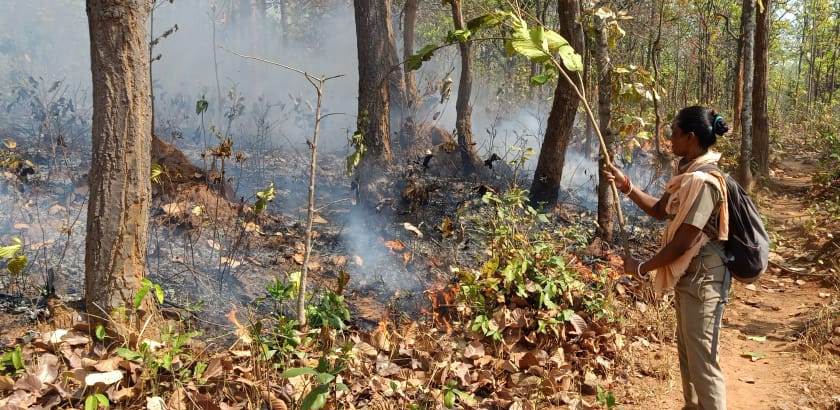
The forest department, along with non-profit organisation, Sangram, is sensitising the local community through rallies, campaigns and meetings. The fire season starts from March and usually lasts till June, writes Deepanwita Gita Niyogi
With approaching summer, incidents of forest fire increase in India. Sal forests are at particular risk due to the accumulation of dry leaves on the ground. Easily inflammable, a blaze is difficult to put out once it starts as it spreads quickly often aided by strong wind. Long dry spells and the absence of summer showers add to the problem.
The Similipal National Park and Tiger Reserve in Mayurbhanj district of Odisha, unique for its continuous stretch of Sal trees, faced a grave situation last year as fire engulfed the forest. This time, the forest department is taking no chances. Along with non-profit organisation, Sangram, it is sensitising the local community through rallies, campaigns and meetings. The fire season starts from March and usually lasts till June.
Awareness drive is important as burning the undergrowth to facilitate mahua flower collection is one of the primary causes behind forest fires. This is an important economic activity on which many tribal families depend on for livelihood, said regional chief conservator of forest Yogajayananda. He is based in Baripada, the district headquarters of Mayurbhanj.
Besides regular meetings on fire preparedness, sensitisation is on in all the surrounding and inside villages of Similipal, mostly targeting forest dwellers, who gather the small pale yellow flowers. “We have involved participatory rural appraisal members, priests and even tribal leaders to talk to the people. District level action plan has been prepared across Odisha for fire management and control. It is being seen as a collective responsibility,” the forest officer added.
Forest fires in India
Forest fires occur regularly in India and 54.40 percent of forest in the country is exposed to occasional fires, according to the Forest Survey of India. Data compiled by the Global Forest Watch, an online platform which monitors world’s forests, shows that between March 1, 2021 and February 21, 2022 there were 22,076 fire alerts. This is unusually high compared to previous years, it says.
“Last year, there were more than 56,000 fire points across Odisha where fire incidents broke out. Of these Similipal had 2000,” Yogajayananda said. Continuous dry spell and extreme hot weather intensified the fire in Similipal.
Apart from mahua flower collection, other factors also contribute to forest fires here. In some villages lying close to the forest, people light fire as a safety measure in their backyards to repel ticks and reptiles. Such fires often left unattended lead to uncontrollable blaze.

Once a fire starts at a particular spot, it is difficult to put it out quickly. The region’s undulating topography and vast expanse make firefighting a daunting task involving a great deal of time and effort. Movement with equipment takes time, sometimes up to two-three hours, and the exercise continues even till night, said Snehalata Dhal, a forester in charge of the Pithabata north wildlife range in the south Similipal division.
Keeping in mind the vastness of the area, historical data helps the forest department in identifying those areas which are prone to more risks from fires. Then there are dedicated firewatchers and fire squads, the latter comprising about 10 members, posted in vulnerable stretches. This is for daily patrolling and timely alerts in case something happens.
To extinguish fires, blower machines come in handy. These put out fires and also help prevent them by clearing the ground by removing dry leaves lying in heaps. Dhal’s team has four such machines with which the squad is always on the move.
A helping hand
While the forest department is ready for any kind of eventuality, dedicated individuals are also chipping in. Sanjukta Basu has been working with the forest department through her organisation Sangram founded in the 1990s. She informed that meetings aimed at awareness on forest fires usually last 40 minutes. She has covered 30-odd villages in and around Similipal this time.
Her colleague Vanoo Mitra Acharya, who founded the organisation, said in Similipal, fire spreads on the ground and is not crown fire like in the pine forests of northern India. “But fires are always due to some human activity. Carelessness on the part of forest dwellers gathering mahua flowers is responsible to an extent. But more serious is the issue of poaching. Poachers set out to trap herbivores and light fires to trap the animals.”
Odisha-based wildlife conservationist and honorary wildlife warden of Angul district, Aditya Panda, is satisfied that last year the fire situation received the attention that was due. So, naturally there is going to be a lot of watch and ward once the fire season starts this year in Similipal. “It is not just awareness campaigns this time. The forest department staff is being imparted training and sufficient equipment has been procured for firefighting across the state. So, this year fire incidents will be lesser and more under control.”
Captions and credits:
Credits: Forest department
Fire 1: Sal forests are at particular risk from fires due to the accumulation of dry leaves on the ground.
Fire 2: Similipal’s undulating topography and vast expanse make firefighting a daunting task involving time and effort.
Fire 3: Blower machines are used to extinguish fires.
Fire 5 or Fire 6: In Similipal, fire spreads on the ground and is not crown fire like in the pine forests of northern India.











